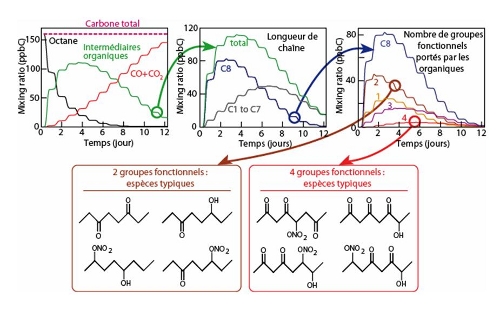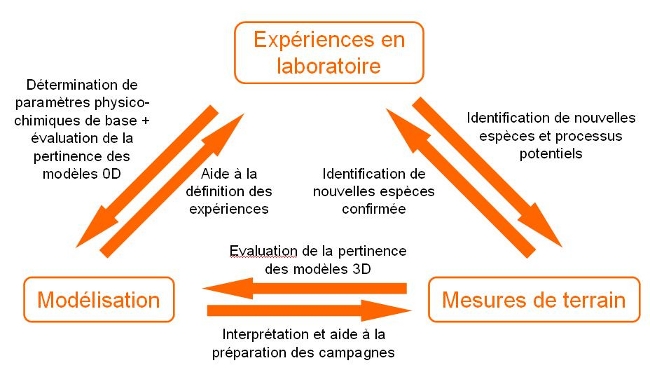Evolution of Organic Carbon Activities
The theme "Evolution of Tropospheric Organic Carbon and its Impacts" is designed to study the evolution and impacts of reactive compounds present in the atmosphere. Among these species, the volatile organic compounds (commonly abbreviated VOC) are one of the determinants of the tropospheric photochemical chemistry. The progressive oxidation of this atmospheric organic matter in CO2 goes through the formation of a large number of secondary species (Figure 1). These intermediary compounds are highly functionalized and play a crucial role on the degradation of air quality but also in the feedback of atmospheric chemistry climate:
- This secondary fraction of organic matter has low volatility, is soluble and can therefore be transferred to condensed phases (formation of secondary organic aerosols (SOA) or dissolution in the hydrometeors). These phase changes induce profound changes in the physicochemical and optical properties of condensed phases and will especially affect the Earth's radiation balance by absorption-diffusion of solar or telluric radiation or by affecting the formation, the life span and properties of clouds.
- This secondary fraction among which includes both oxygenated species easily photolysables such as aldehydes and reservoir species of NOx such as organic nitrates (Figure 1), thus contains a residual reactivity. This secondary fraction which is more likely to be transported far from source regions, can then affect the balance of the photo-oxidants species (ozone, radicals) and the concentrations in reactive nitrogen.
 |
Figure 1 : Simulation of evolution of organic carbon in gas oxidation of octane: (a) distribution of carbon; (b) distribution of secondary organic carbon according to the length of the carbon chain; (c) distribution of the species in C8 according to the number of functional groups by molecules. Typical species in C8 with 2 and 4 functional groups are carried forward as an example. These di-functional species are sufficiently water-soluble to be dissolved in the aqueous phase of cloud systems. Species in C8 with 4 functional groups have low vapor pressures and are thus likely to condense on pre-existing aerosols.
In order to identify these intermediate species and quantify their processes of formation in the atmosphere LISA combines experimental approaches in the field, of modeling (generator of explicit chemical schemes and 3D model), and laboratory experiments (atmospheric simulation chambers) (Figure2).
 |
Figure 2: Interaction and complementarity of experiments in the laboratory, field measurements and modeling to study the evolution of organic matter in the atmosphere
The activities of this thematic group are organized around the different impacts of these intermediates organic compounds along three main axes :
- Axis 2 : The evolution of organic carbon and its impact on the balance sheet of photo-oxidants
- Axis 3 : The evolution of organic carbon and its role in the transport of nitrogen oxides

